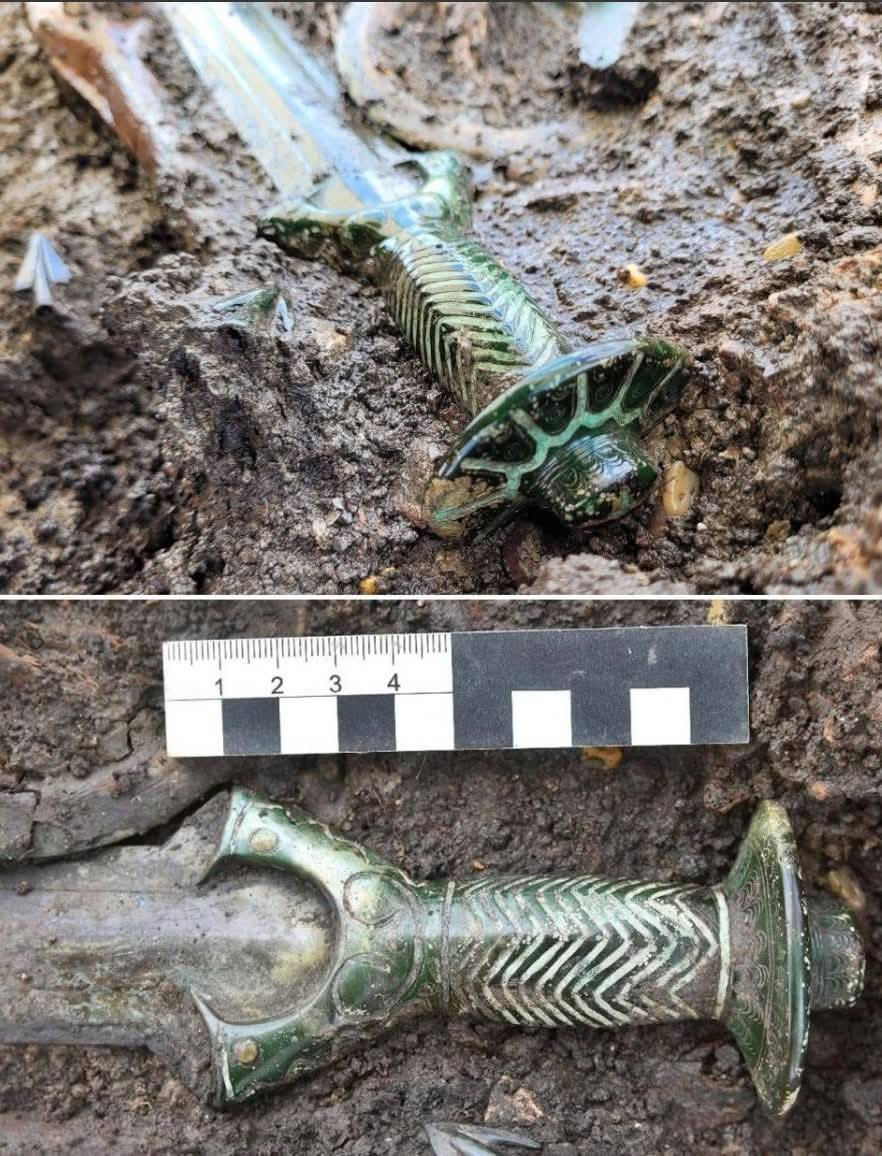3,000-Year-Old Bronze Age Sword Unearthed in Germany – A Window Into Ancient Warriors

In a discovery that illuminates the artistry and warfare of Europe’s distant past, archaeologists from the Bavarian State Office for the Preservation of Monuments have uncovered an exceptionally well-preserved Bronze Age sword in Nördlingen, a historic town nestled in Bavaria, Germany. Estimated to be around 3,000 years old, the sword’s near-perfect condition offers a rare and breathtaking glimpse into life — and death — during the late Bronze Age. ⚔️
A Timeless Weapon of Bronze and Craftsmanship

The sword, gleaming with a vivid green patina characteristic of aged bronze, was found alongside the remains of a man, woman, and child. Surrounding the bodies were various grave goods — ornaments, pottery, and weaponry — suggesting a high-status burial and possibly a family of noble or warrior descent.
What makes this discovery extraordinary is the sword’s exceptional preservation. Experts note that the blade still reflects light, its hilt intricately designed with geometric patterns that speak to both functionality and aesthetic mastery.
According to Dr. Matthias Pfeil, head of the Bavarian State Office for the Preservation of Monuments,
“Finding a Bronze Age weapon in such condition is exceedingly rare. This sword could easily have been wielded the day it was buried.”
An Echo from Bavaria’s Ancient Past
The find dates back to approximately 1300 BCE, a period when Central Europe was a vibrant hub of metalworking innovation, trade, and ritual practice. The sword likely belonged to the Urnfield culture, named for its tradition of cremation burials placed in urns and its skillful use of bronze tools and weapons.
Nördlingen itself is no stranger to ancient secrets — the region has long been known for its burial mounds, though most were looted centuries ago or excavated during the 19th century. That makes this untouched grave, with its intact artifacts, an archaeological treasure of rare integrity.
Weapons, Status, and Symbolism

Bronze Age swords were more than mere instruments of battle — they were symbols of power, prestige, and often, divine protection. The Nördlingen sword’s craftsmanship suggests it may have been ceremonial, yet functional enough for combat.
Archaeologists believe its placement within a family grave hints at deep ritual meaning — perhaps representing the family’s lineage, the warrior’s honor, or the transition of souls to the afterlife. The inclusion of both adults and a child may indicate a tragic event or an intentional group burial, possibly due to plague, famine, or social ritual.
A Bridge Between Myth and History
This discovery deepens our understanding of Bronze Age Bavaria, a region once at the crossroads of migration, trade, and cultural exchange across Europe. Each artifact recovered from the site — from pottery fragments to the gleaming bronze blade — paints a portrait of a society both advanced and mysterious, where artistry and mortality intertwined.
Preserving the Past for the Future
The sword and its accompanying artifacts are now being carefully conserved and analyzed. Future studies will focus on the metal composition, crafting techniques, and DNA analysis of the remains to determine kinship and cultural identity.
The Nördlingen sword stands not only as a relic of war but as a symbol of humanity’s enduring craftsmanship and memory. Across 30 centuries, its blade still speaks — of courage, artistry, and the stories that time itself could not erase. 🌍⚔️











